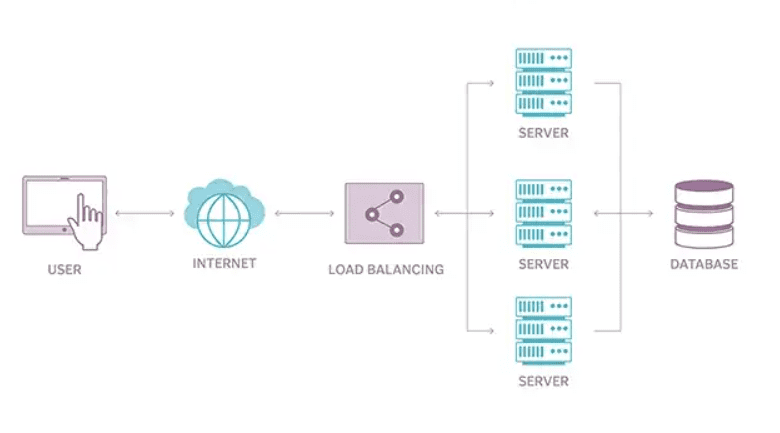Reduce Latency with Load Balancing

Remember any web application crashes? The banking website crash in June 2022, Spotify’s mysterious downtime during Covid-19, or the most famous Flipkart big billion days server failure!
In an age when websites and applications are the most crucial part of any business, businesses must ensure a seamless user experience. However, maintaining low latency can be challenging as the number of users and requests rises.
In this article, we will talk about reducing latency through Load balancing and how businesses can use it as the most effective way to prevent high traffic and maintain multiple servers available at all times.
So without further ado, let’s begin!
Website Downtime Overload: Overview
Web crashes and periods of outage are known as website downtime. It is mainly induced by more than one factor.
Let’s dive deep into two main factors of downtime.
1. Server overload
The constant displaying of error codes, delaying serving requests, taking too long to load the whole website, or showing partial content is usually caused by overload.
2. Malicious cyber attacks
The increasing business and expansion of websites come with the threat of cyber attacks.
Distributed denial of services DDoS may be another attempt to crash websites by overwhelming the target with a flood of traffic.
How can Load Balancing Help Resolve The Issue?
Load balancing efficiently helps redirect the requests to multiple servers to ensure that no single server is overwhelmed with requests. It helps manage the server by using firewalls and blocking traffic overload.
It helps to reduce latency, stops the server from slowing down, crashing, and dropping requests, and ensures that users have a smooth and responsive experience. Load balancing also increases the speed of processing requests accurately and more rapidly.
Benefits of Load Balancing
- Load balancing acts as an intermediary and ensures the connections between the servers and the user, and without it, the applications, websites, and databases are at risk of downtime.
- In a high-traffic website, there is a need for multiple servers numbering thousands to maintain functioning and accuracy. Load balancing is used to avoid underperformance and crashing of a website.
- Load balancing not only ensures working and accuracy but also comes with the advantage of flexibility by redirecting the traffic to other servers when the required ones are under maintenance.
- It provides scalability, redirects the accommodated demands without causing disruption, and avoids downtime by involving new servers.
- It has the intelligence to redirect a task to the servers in active state and prevents them from reaching servers that are not working correctly.
- Load balancing is not only proving to be helpful virtually, but it has hardware load balancers such as appliances and redirects the networks based on the number of connections, performance, and processor utilization.
- These load balancers are cost-effective when deployed in software as a cloud service called Load Balancer as a Service LBaaS, which lessens the work of maintenance, upgrade of installed servers, and management.
How does Load Balancing work?

Load balancing acts as a traffic police to ensure the web traffic is directed in the right direction. It makes sure the website runs securely and with ease for all users. Its main functions are:
- The management of traffic spikes and the prevention of spikes on a single server.
- The addition of resilience to the computing environments.
- The security of both physical and virtual performance of a computing resource.
The cloud-based load balancers are offered as a service with high levels of elasticity, flexibility, and access to resources and use methods and algorithms to optimize the traffic. They work on distributing networks on multiple resources and server groups, thus preventing websites from crashing.
The algorithms, coupled with a predetermined distribution pattern, prevent server overload. These techniques and algorithms manage the entire process, giving a range of load balancers one has to use.
The algorithms are categorized into two types: weighted and non-weighted.
Weighted algorithms work based on the weight of specific servers and the cumulative weight of all servers. Whereas the non-weighted algorithms work based on the principle of all servers having the same capacity; hence they cannot optimize the server capacity.
How Can Cubet Help You Manage Downtime?
Low latency is imperative to offer a seamless user experience. We ensure that our clients experience the least latency by utilizing load-balancing strategies and real-time monitoring.
Cubet approaches load balancing using two techniques: Round robin and IP hash.
1. Round-robin load balancing
It involves distributing incoming requests to different servers in a rotating order. Round-robin load balancing ensures that the load is distributed evenly across all servers and can help to reduce latency.
2. IP hash load balancing
This method uses a hash function to map incoming requests to specific servers based on the IP address of the client. This helps ensure that requests from the same client are sent to the same server, reducing latency.
In addition to these techniques, we also use real-time monitoring and analysis to identify and respond to potential issues. This enables us to rapidly find and fix any issues contributing to increased latency.
Key Takeaway
The importance of load balancing to minimize downtime and ensure the system’s resilience accentuates when millions of users access an application. At Cubet, we understand the importance of low latency and its undeniable impact on a business. We implement load balancing as a standard part of our software development process to ensure application scalability. Distributing traffic across multiple servers ensures no single server is overwhelmed, resulting in faster response times and lower latency for our clients.
Seeking a scalable web solution? Contact Us Today!